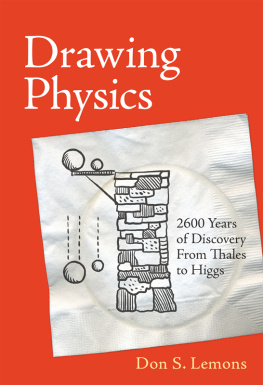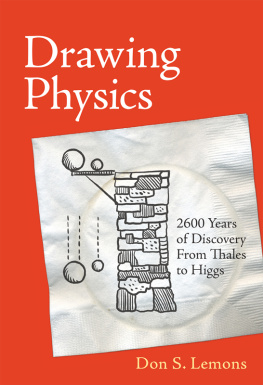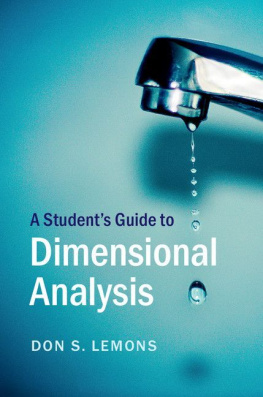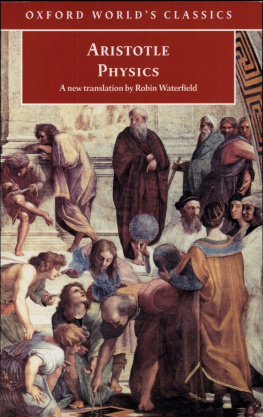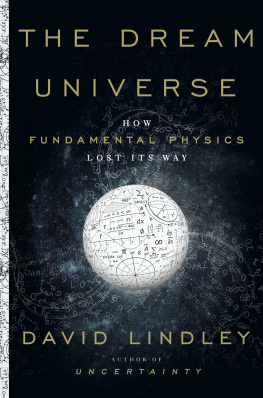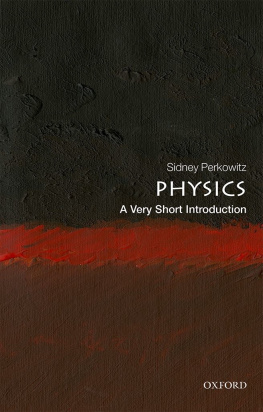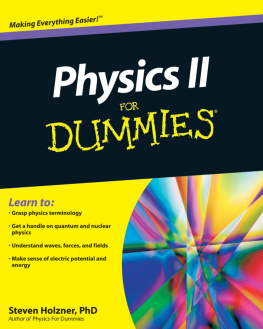
Drawing Physics
2,600 Years of Discovery from Thales to Higgs
Don S. Lemons
with drawings by Jesse Graber
The MIT Press
Cambridge, Massachusetts
London, England
2017 Massachusetts Institute of Technology
Illustrations Jesse Graber and Don Lemons, reprinted with permission (unless otherwise noted).
All rights reserved. No part of this book may be reproduced in any form by any electronic or mechanical means (including photocopying, recording, or information storage and retrieval) without permission in writing from the publisher.
This book was set in Stone Serif by Toppan Best-set Premedia Limited. Printed and bound in the United States of America.
Library of Congress Cataloging-in-Publication Data
Names: Lemons, Don S. (Don Stephen), 1949- author.
Title: Drawing physics : 2600 years of discovery from Thales to Higgs / Don S. Lemons.
Description: Cambridge, MA ; London, England : The MIT Press, [2017] | Includes bibliographical references and index.
Identifiers: LCCN 2016028491| ISBN 9780262035903 (hardcover ; alk. paper) | ISBN 0262035901 (hardcover ; alk. paper)
eISBN 9780262338738
Subjects: LCSH: Physics--History. | Physics--History--Pictorial works.
Classification: LCC QC7 .L44 2017 | DDC 530.09--dc23 LC record available at https://lccn.loc.gov/2016028491
ePub Version 1.0
Preface
Galileos claim that mathematics is the language of science applies to no science more than to physics. But mathematical description requires great effort. How is that effort begun? The answer, more often than not, is with a drawing of an as yet wordless, pre-mathematical picture of reality. To draw is to see the world in a particular way and to inform the self with an understanding of the world. Drawing the important elements of physical reality diminishes the psychological difficulty of articulating that reality in language of any kind. Subsequent progress allows one to refine an initially crude drawing.
Carefully constructed drawings play a large role in teaching and in learning physics. Routinely I require my own students, when beginning to analyze a physical situation, to produce a drawing that represents important physical elements placed in right relation. Many of my students are visual learners and require little inducement, but the task benefits all. The drawing or diagram produced, sometimes called the cartoon approximation, guides the whole process of investigation.
Drawings are a humble but effective tool of the physicists craft and part of the tradition of physics that is passed on from colleague to colleague and from teacher to student. Certain drawings achieve relative fame and permanence on the pages of research journals, monographs, and textbooks. Many more exist only briefly on chalkboards or scraps of paper.
Drawings that jump-start a physical inquiry and encapsulate its results require neither rich detail nor realistic perspectiveonly simplicity and clarity. A good physics drawing is in many ways like a good epigram: spare and, once composed, its elements cannot be subtracted from, added to, or rearranged without diminishing the composition. Also, like a good epigram, a good drawing is worth committing to memory.
This volume contains fifty-one exemplary drawings from twenty-six centuries of physics discovery arranged in chronological order. Each drawing presents a single idea. Most of the drawings appear frequently in other physics books, and all have survived the test of my own teaching and learning. Each drawing anchors an episode of the story I tell. An essay reviews the physics and places it in historical context.
When I started this project I was not sure that physics could be presented in any depth or breadth in this way, but I wanted to try. I am, after all, a theoretician who uses mathematics in research and a teacher whose duty it has been to find the mathematics most appropriate for his students. But to abstract the essential physics from a complicated situation and to represent that physics in a drawing is also close to the work of a theoretical physicist and teacher. I was delighted to learn that the word theory is related, through its Greek roots, to the word seeing. And, of course, the phrase I see often means I understand. Thus, to draw is to draw out, to draw out is to see, and to see is to understand.
Here is the resultadmittedly an episodic and incomplete account. I am satisfied, but an unbiased evaluation necessarily falls to others. This book is for readers interested in the world in which they live but who, for various reasons, know little mathematics or physics. My hope is that Drawing Physics will, by appealing to their visual sense, help these readers say, Now I see, and now I understand.
Dedications and Acknowledgments
My father, the late Reverend Wishard F. Lemons, would have been pleased that, finally, I had written a book he could read. Another dear one who has passed on, Anthony Gythiel, friend, literary scholar, and medievalist, encouraged me to include essays on medieval physics. Memory Eternal, Wishard and Tony! To you and to my young grandsons, Abel and Emil, I dedicate this book.
I also want to acknowledge friends and family members, Galen Gisler, Christina Gore, Clark Lemons, Rick Shanahan, and David Watkins, whose reading and critique of the text helped improve it. Dan Umanskys class on Renaissance history inspired the essay on Leonardo. Jeremy Bernstein answered my questions on Einstein. Terrence Figy, Holger Meyer, and Nick Solomey advised me on the Higgs boson.
The seminars in which I participated at St. Johns College in Santa Fe, New Mexico, encouraged me to study the original sources upon which many of these essays are based. The Society of Physics Students at Wichita State University and the Natural Science Seminar at Bethel College of North Newton, Kansas, responded helpfully to presentations of the text.
I am long overdue in acknowledging Trevor Lipscombe for editing my earlier books and for giving me good advice on this one. John Thornton, my agent, placed Drawing Physics with the MIT Press. Thanks to Trevor and John and the helpful staff at MIT. And I dont believe I could have found a better illustrator for Drawing Physics than Jesse Graber.
My teachers and mentors over the decades, Robert Armstrong, Harold Daw, Peter Gary, Michael E. Jones, Robert Romer, and Dan Winske, helped prepare me, in various ways, for the task of writing this book. With pleasure, I offer this text to Bill Peter, physicist and longtime friend. I hope he will have an opportunity to read it.
Finally, with much feeling I acknowledge Allison, my beloved wife of many years, for her support of my writing habit, for her critical reading, and for her many suggestions that have strengthened Drawing Physics.
Antiquity
1.Triangulation (600 BCE)
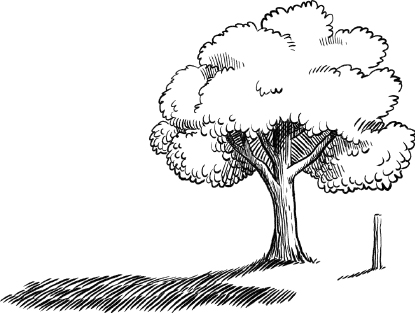
Figure 1
When a surveyor cannot measure a certain distance directly, say the width of a river or the height of a tree, either by counting paces or by laying out lengths of a standard measure, he can use the properties of triangles to determine the distance. This idea, which goes back to Thales of Miletus (624565 BCE), is one of the first in the history of physics and mathematics.
Miletus was, in the sixth century BCE, a Greek port on an island off the west coast of Asia Minor, now modern Turkey, and Thales was an early philosopher or lover of wisdom. Thales traveled far from Miletus in his search for wisdomto Babylon and across the eastern Mediterranean to Egypt. Egypt, even in the sixth century BCE, was known for its ancient civilization. After all, the great pyramids were built in approximately 2500 BCE. What Thales found in Egypt, if not wisdom, was the practical knowledge of local Egyptian land measurers or
Next page
